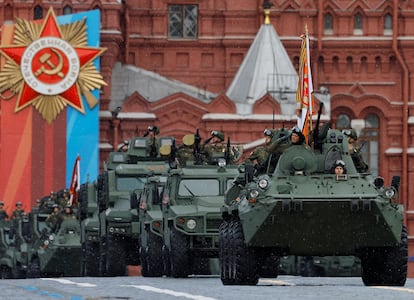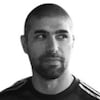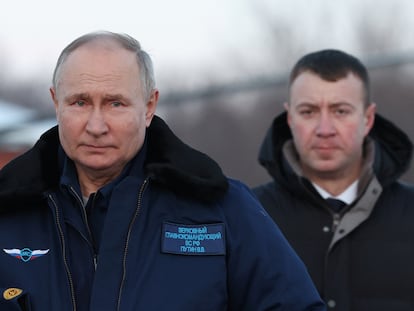Putin issues new threat to West on Victory Day in Moscow: ‘We will not allow anyone to threaten us. Our strategic forces are always combat ready’
‘Russia is now going through a difficult, milestone period, the fate of the Motherland, its future, depends on each of us,’ the president told his troops


For Russian society, Victory Day has become a reminder of the stalemate of its “special military operation” in Ukraine. Vladimir Putin presided over his third military parade on Thursday in Moscow’s Red Square since ordering his Armed Forces to take Kyiv. The Great Patriotic War, as Russia refers to the triumph over the Third Reich in World War II, took the Soviet Union four years to achieve. “Russia is now going through a difficult, milestone period, the fate of the Motherland, its future, depends on each of us,” Putin told his troops from the pulpit, where the presence of international leaders could be counted on the fingers of two hands.
The cold and a flurry of snow in the middle of May did not help the military parade. Neither did the fact that it fell on a Thursday — giving Russians the opportunity to enjoy a four-day long weekend — nor that for security reasons other parallel events were suspended both in Moscow and in the rest of the country. Very few people came out to view the march of vehicles through the center of the capital, where for the first time the authorities suspended the parade of the so-called Immortal Regiment. This initiative — a citizens’ march where participants carry portraits of grandparents and parents who suffered in World War II — arose spontaneously last decade, but ended up being appropriated and politicized by the Kremlin.
Russia’s “holiest” day has in previous years constituted a show of force by the military. On this occasion, however, the only armored vehicle crossing Red Square was an old World War II T-34 tank, followed by some six dozen vehicles, mostly armored transports — the Tigr-M, Taifun-K and several BTRs — and several missile launcher systems that are deployed in the bombardment of Ukraine: the state-of-the-art S-400 missile system and the 9K720 Iskander hypersonic missile launcher. Also on parade was the spearhead of Russia’s nuclear forces, the Yars intercontinental ballistic missile.
“Russia will do everything to avert a global confrontation. At the same time, we will not allow anyone to threaten us. Our strategic forces are always combat ready,” Putin said in his second threat to the West this week. On Monday, the Kremlin issued an order to its non-strategic nuclear forces, the second line of Russia’s arsenal in terms of destructive capability and capable of delivering a first strike in a hypothetical conflict, to conduct exercises.
Problems with supplying the front line may have prompted the Kremlin to play the nuclear card. Satellite images of Russian weapons depots analyzed by the Institute for the Study of War suggest that Moscow is “largely” sustaining its war effort “with material withdrawn from stockpiles” rather than from the manufacture of new weapons and vehicles.
There is no family in Russia, Belarus, Ukraine, and many other eastern European countries that would not have suffered the loss of a loved one at the front during World War II. Today, the Kremlin tries to draw a historical thread between the pain caused by Hitler’s Germany to justify its invasion of Ukraine. “Revanchism, mockery of history, and the desire to justify the current followers of the Nazis are part of the general policy of Western elites to foment more and more regional conflicts,” Putin said.
A nod to China
The Russian leader rewrote the history books during his speech to justify his expansionist ambition. “During the first three long, difficult years of the Great Patriotic War, the Soviet Union, all the republics of the former Soviet Union fought the Nazis practically one on one, while almost the whole of Europe was working for the military power of the Wehrmacht,” the Russian leader declared. By the time Germany launched its invasion of the USSR in June 1941 on the borders of what had been Poland two years earlier, the United Kingdom was already resisting the Luftwaffe’s scourge, French partisans were fighting underground, and Hitler’s war machine was being confronted in the Balkans and North Africa. Putin also declined to mention the 1939-1941 Molotov-Ribbentrop treaty of non-aggression in place with Berlin until Hitler set his sights on Moscow.
The president also provided a nod to Beijing, his main economic and political supporter in the Kremlin’s military campaign against Ukraine, in recalling the courage of the people of China, who fought for their independence against the aggression of militaristic Japan. Tension between Moscow and Tokyo is rising. The Kremlin has strengthened its military collaboration with the North Korean regime, while Japan has sent aid to Ukraine. In the background is the dispute over the Kuril Islands, seized by the USSR during World War II. Moscow recently banned foreign ships from entering the archipelago’s waters.
The Kremlin did not invite the leaders of countries it considers “unfriendly” for failing to support its offensive on Ukraine. However, neither did it have a massive representation from the rest of the world. Present on the guest rostrum were the leaders of the five Central Asian republics with which Moscow has close economic and political relations — Kazakhstan, Kyrgyzstan, Uzbekistan, Tajikistan, and Turkmenistan — and four other allied countries — Belarus, Cuba, Laos, and Guinea-Bissau.
Sign up for our weekly newsletter to get more English-language news coverage from EL PAÍS USA Edition
Tu suscripción se está usando en otro dispositivo
¿Quieres añadir otro usuario a tu suscripción?
Si continúas leyendo en este dispositivo, no se podrá leer en el otro.
FlechaTu suscripción se está usando en otro dispositivo y solo puedes acceder a EL PAÍS desde un dispositivo a la vez.
Si quieres compartir tu cuenta, cambia tu suscripción a la modalidad Premium, así podrás añadir otro usuario. Cada uno accederá con su propia cuenta de email, lo que os permitirá personalizar vuestra experiencia en EL PAÍS.
¿Tienes una suscripción de empresa? Accede aquí para contratar más cuentas.
En el caso de no saber quién está usando tu cuenta, te recomendamos cambiar tu contraseña aquí.
Si decides continuar compartiendo tu cuenta, este mensaje se mostrará en tu dispositivo y en el de la otra persona que está usando tu cuenta de forma indefinida, afectando a tu experiencia de lectura. Puedes consultar aquí los términos y condiciones de la suscripción digital.
More information
Archived In
Últimas noticias
Most viewed
- Sinaloa Cartel war is taking its toll on Los Chapitos
- Oona Chaplin: ‘I told James Cameron that I was living in a treehouse and starting a permaculture project with a friend’
- Reinhard Genzel, Nobel laureate in physics: ‘One-minute videos will never give you the truth’
- Why the price of coffee has skyrocketed: from Brazilian plantations to specialty coffee houses
- Silver prices are going crazy: This is what’s fueling the rally










































